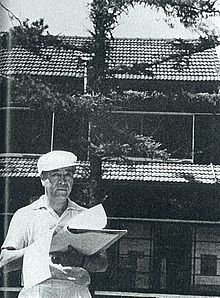Koyama Keizo
Koyama Keizō ( Japanese 小山 敬 三 ; born August 11, 1897 in Komoro ( Nagano Prefecture ); died February 7, 1987 ) was a Japanese painter in Yōga -, i.e. in the western style of the Taishō and Shōwa periods .
life and work
Koyama attended the Keiō Gijuku College in Tokyo, the predecessor institution of today's Keiō University , but left it without a degree and began studying painting at the Kawabata Art School ( 川端 画 学校 , Kawabata Gagakkō ) under Fujishima Takeji . In 1918, his works were accepted for the fifth Nikakai ( 二 科 会 ) exhibition and for the fifth exhibition of western-style painting at Nihon Bijutsuin . In the same year he also enrolled in Nihon Bijutsu-in.
On the advice of the novelist Shimazaki Tōson , Koyama went to France in 1920 and studied at the Académie Colarossi under Charles Guérin . The following year he was accepted as a guest member in the artists' association Shun'yō-kai ( 春陽 会 ). In the Salon d'Automne he was able to show his picture “Bretagne” ( ブ ル タ ー ニ ュ , Burutānyu ). In 1924 he became a member of the Shun'yō-kai and in 1927 he had his first solo exhibition at the Vallenne Gallery in Paris. The French government acquired his painting "Hills in Castile" ( カ ス テ ヤ の 丘 , Kasuteya no oka ).
In 1928 Koyama returned to Japan, left the Shun'yō-kai in 1933 and became a member of the Nikakai. He also left this in 1939. Together with Ishii Hakutei , Arishima Ikuma and others he founded the Issui-kai ( 一 水 会 ).
After the war he showed his work at the Nitten exhibition, where he in 1959 for his picture " Himeji Castle in early summer" ( 初夏 白鷺 城 , Shoka Shirasagi-jō ) and "Himeji Castle" ( 白鷺 城 , Shirasagi-jō ) on the Nitten was awarded. For the Nitten he was then also active as a juror, administrator and finally as an advisor. In 1960 he became a member of the Japanese Academy of Arts . In 1970 he was honored for his cultural merits and awarded the Order of Culture in 1975 .
In 1975, Koyama's hometown Komoro built a museum for him, the "Municipal Koyama Keizō Art Museum Koromo" ( 小 諸 市立 小山 敬 三 美術館 , Komoro shiritsu Koyama Keizō bijutsukan ).
Koyama's well-known works include the “Bridge of Toledo” ( ア ル カ ン タ ラ の 橋 , Arukantara no hashi ), 1927 and the “Portrait of a Woman” ( 婦人 像 , Fujin-zō ; 1951). His pictures, which show the Asama volcano, are also known, approaching the flatness of the Nihonga style. - In 1950 his translation of Vollard's Souvenirs d'un marchand de tableaux appeared under the title Gashō no omoide ( 画 商 の 想 い 出 ).
Remarks
- ↑ As usual in Japan, the name suggests that they met on the first ( 一 ) Wednesday ( 水 曜 日 ) of the month ( 会 ).
- ↑ Nitten ( 日 展 ) is the usual abbreviation for Nihon bijutsu tenrankai ( 日本 美術展 覧 会 ), the successor organization of the originally state art exhibition Bunten, or Teitan.
literature
- S. Noma (Ed.): Koyama Keizō . In: Japan. An Illustrated Encyclopedia. Kodansha, 1993, ISBN 4-06-205938-X , p. 835.
- Tazawa, Yutaka: Koyama Keizō . In: Biographical Dictionary of Japanese Art '. Kodansha International, 1981. ISBN 0-87011-488-3 .
- Laurance P. Roberts: Koyama Keizō . In: A Dictionary of Japanese Artists. Weatherhill, 1976. ISBN 0-8348-0113-2 .
Web links
| personal data | |
|---|---|
| SURNAME | Koyama, Keizo |
| ALTERNATIVE NAMES | 小山 敬 三 (Japanese) |
| BRIEF DESCRIPTION | Japanese painter |
| DATE OF BIRTH | August 11, 1897 |
| PLACE OF BIRTH | Komoro ( Nagano Prefecture ) |
| DATE OF DEATH | February 7, 1987 |

